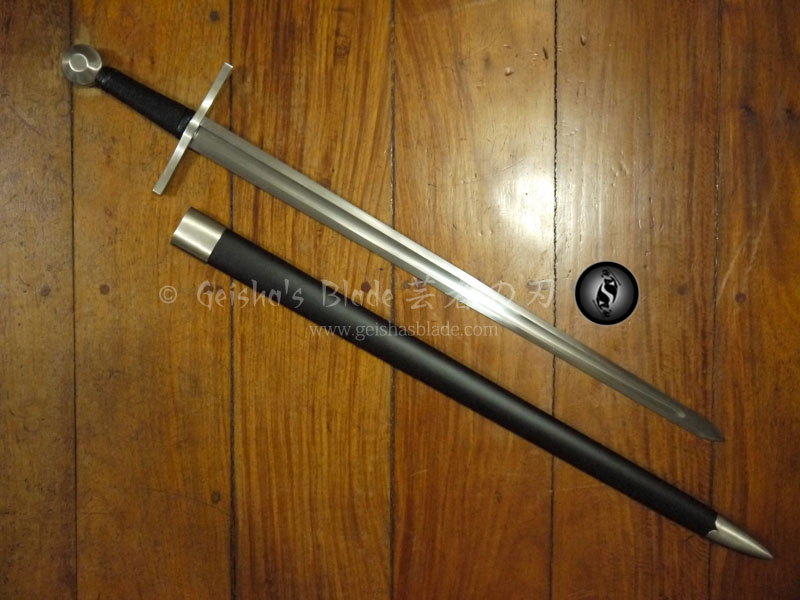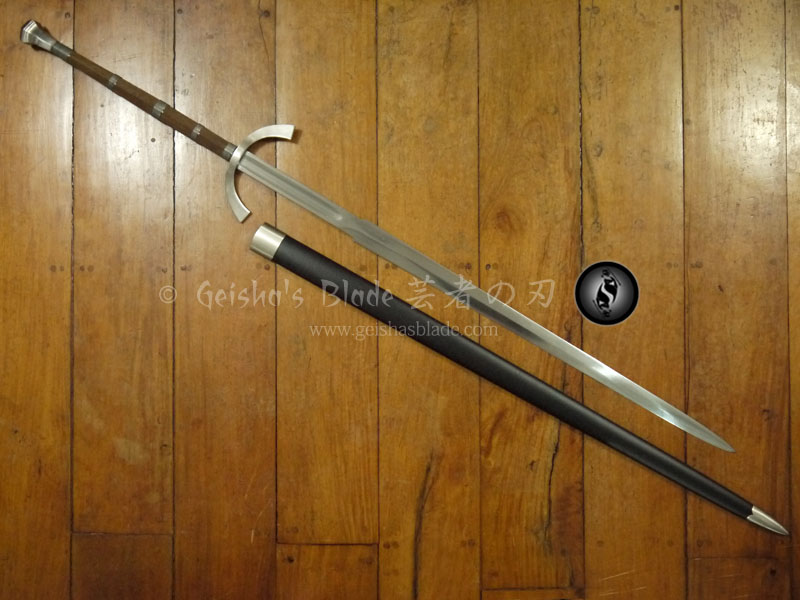The numbers 1095, 1060, 1050, 1045 represents the type of steel used on our blades. The carbon content of the steel is expressed as a ‘point’ of carbon. Each point signifies that 0.01% of that steel is carbon. For example, a 45 point steel will contain 0.45% carbon. Steels with carbon contents lower than around 40 points (0.4%) WILL NOT HARDEN MEASURABLY. The table below shows some uses for different carbon-content steels.
5-10 points: Nails, wire. Not hardenable.
10-20 points: General use. Not hardenable.
20-30 points: Screws. Some machinery parts.
30-40 points: Machinery parts. Will harden slightly.
40-50 points: Gears, Axles. Will harden.
50-60 points: Crowbars. Tools. Will harden enough to take a good edge.
60-70 points: Swords, axes, cleavers. Chopping blades.
70-100 points: Cutlery. Knives. The lower range of this bracket is used for tougher blades, the upper range for hardness and a longer lasting edge.
We will only discuss here the type of steel used on our blades which is plain carbon steel 10XX.
The Xs refer to points of carbon. For example, 1095 is a plain carbon steel with 95 points (0.95%) carbon; 1060 has 60 points (0.6%) carbon; 1050 has 50 points (0.5%) carbon, while 1045 has 45 points (0.45%) carbon. The higher the carbon content of a blade, the tougher/harder the blade is and will have a longer lasting edge. However, the harder the blade is, the more brittle it is.
1045 Carbon Steel
1045 carbon steel is the ‘minimum’ acceptable steel in creating a fully functional real sword. It can make quite an excellent usable sword provided it is tempered properly and it’s way better than stainless steel. Since it only has 0.45% carbon, it is only recommended for kata or suburi and for cutting light/soft targets such as water filled bottles and single roll of tatami or beach mats. It is not recommended to cut hard targets such as fresh green bamboo as it will surely roll its edge, blunt or even nick the edge.
Cutting video with our Raijin Katana 1045 Series (1st Gen) vs Bamboo
We recommend our 1045 Series for cutting soft targets only (water filled plastic bottles, water soaked straw mats), but we tried it on bamboo to show you what it’s capable of—no dents or nicks and the blade remained straight. This was also possible because of good edge alignment.
IMPORTANT NOTE: Last April 2018, we greatly improved our 1045 Series swords. The 2nd Generation 1045 Series now have a more flexible blade like spring steel, subtle wire brushed hamon that looks real, deeper bohi (groove on the blade) which makes the blade more balanced and produces a more pronounced tachi-kaze (sword wind sound). With the improvements we did, we can say our 2nd Gen 1045 swords are better than our 1050 swords. You can now cut bamboos with confidence. See videos below:
Flex Test
>
New subtle wire brushed hamon
2nd Gen 1045 Mugen Katana vs dry bamboo
1050 Carbon Steel
Having 0.5% carbon, we only recommended our 1050 Series for kata or suburi and for cutting light targets such as water filled bottles and single roll of tatami or beach mats. It is not recommended to cut hard targets such as fresh green bamboo as it will surely roll its edge, blunt or even nick the edge.
Kuro Setsuhen Katana 1050 Series vs Bamboo
Just like our 1045 Series swords, recommend our 1050 Series for cutting soft targets only, but we tried it on bamboo to show you what it’s capable of. After hitting 3 nodes (which is the hardest part of the bamboo), the blade did not sustain any damage—no dents or nicks and the blade remained straight. This was also possible because of good edge alignment.
Even though our 1050 Series swords can cut bamboo without any problem, we still don’t recommend it because the blade will easily get dull as 1050 carbon steel doesn’t have a good edge retention compared to higher carbon steels. Unless re-sharpening the blade won’t be a problem for you.
1060 Carbon Steel
Our 1060 Series has 0.6% carbon and will harden enough to take a good edge. Recommended cutting targets are water filled bottles, double roll of tatami or beach mat, and occasional cutting of fresh green bamboo. Frequent cutting of hard targets will eventually dull the edge and sharpening will be needed.
Our 1060 Series is also capable of taking a 45-degree (or more) bend and still returning true, which provides practitioners an ample leeway for a less than perfect cut. You can watch the video below:
Kirishitan Katana 1060 Series vs a very hard and very thick bamboo
1095 Carbon Steel
Our 1095 series has 0.95% carbon, which is very close to the carbon content of tamahagane (steel used in Japan for making nihonto) that has 1-1.5% carbon. Our 1095 line is suitable for heavy cutting (frequent cutting of fresh green bamboo with a diameter of 2.5-3 inches) as it has a longer edge retention. Heavy cutting doesn’t necessarily mean you can cut anything with it. Cutting of trees/tree branches are better left for axes, cleavers, machetes.
If you want your katana to last a very long time, take good care of it and only cut recommended targets.
Additional information:
To explain the 1st and 2nd digits:
The Society of Automotive Engineers (SAE) has established standards for specific analysis of steels. In the 10XX series, the first digit indicates a plain carbon steel. The second digit indicates a modification in the alloys. 10XX means that it is a plain carbon steel where the second digit (zero) indicates that there is no modification in the alloys. The last two digits denote the carbon content in points, see above.
T10 Tool Steel
The “T” stands for High-Speed and the “10” means there is between 0.95% – 1.05% carbon. These types range from the T1 which is between 0.05% – 0.15%, All the way up to T15 which is between 1.20% – 1.30% carbon. Tool steel are primarily used to make tools used in manufacturing processes as well as for machining metals, woods, and plastics. They are generally ingot-cast wrought products, and must be able to withstand high specific loads as well as be stable at elevated temperatures. It is a high speed tool steel that gets extremely hard on the surface but remains springy in the center. Other properties include extremely high abrasion resistance which should mean it will keep its edge longer and resist scratches.



